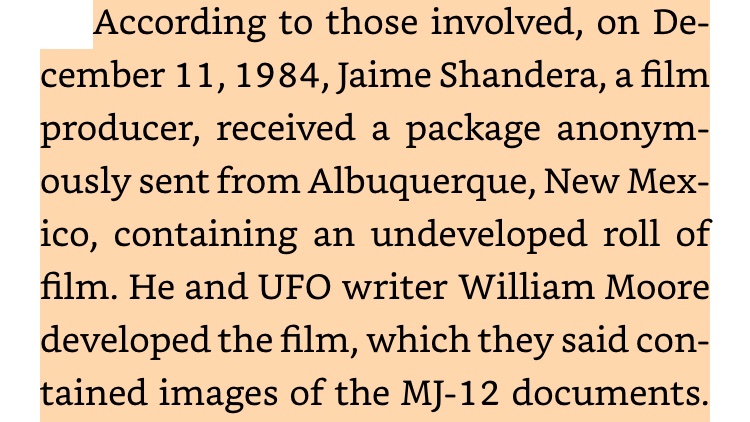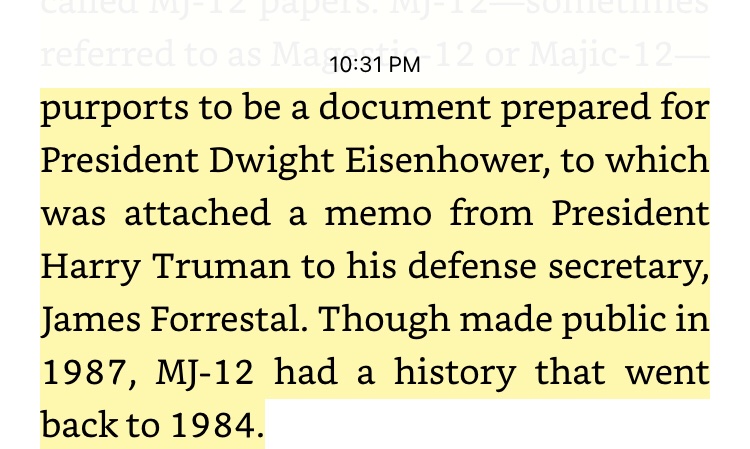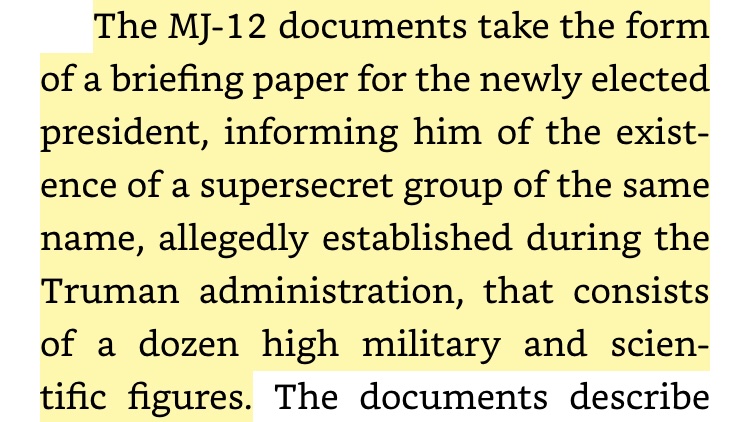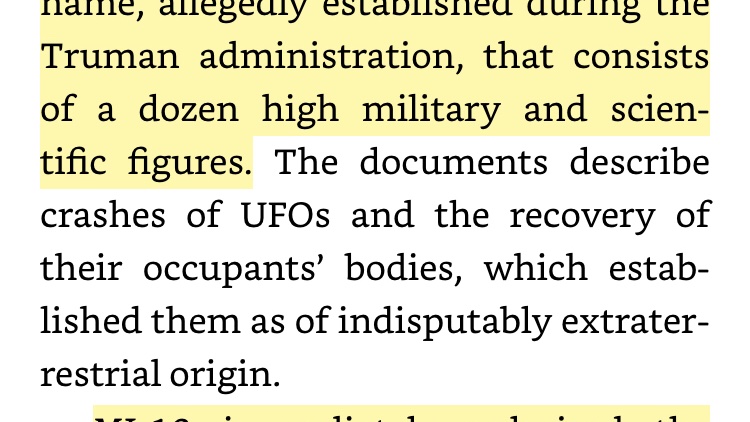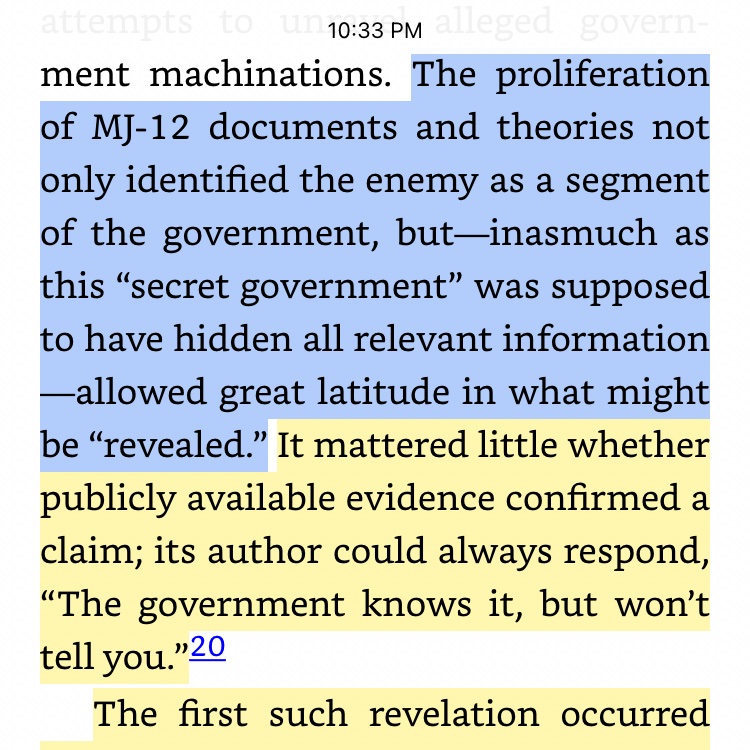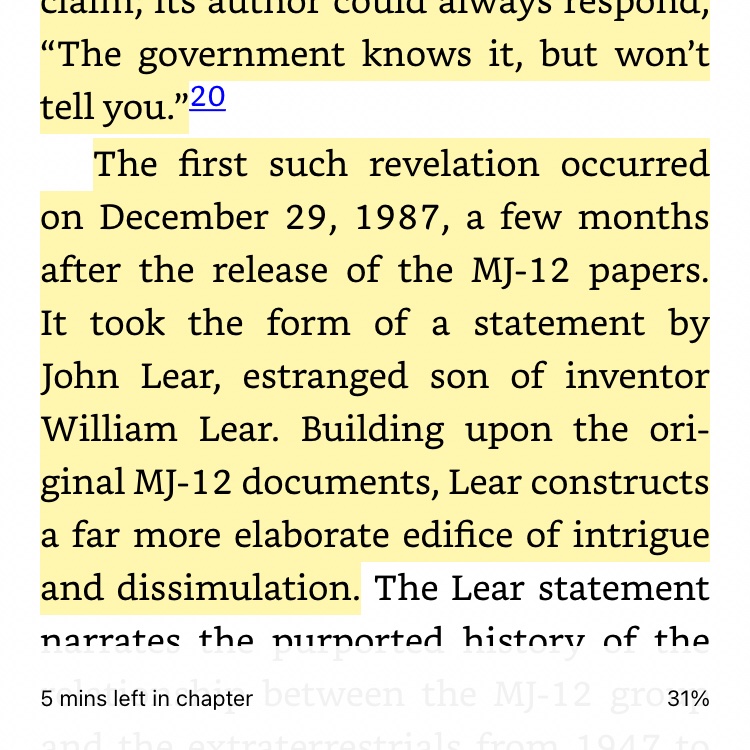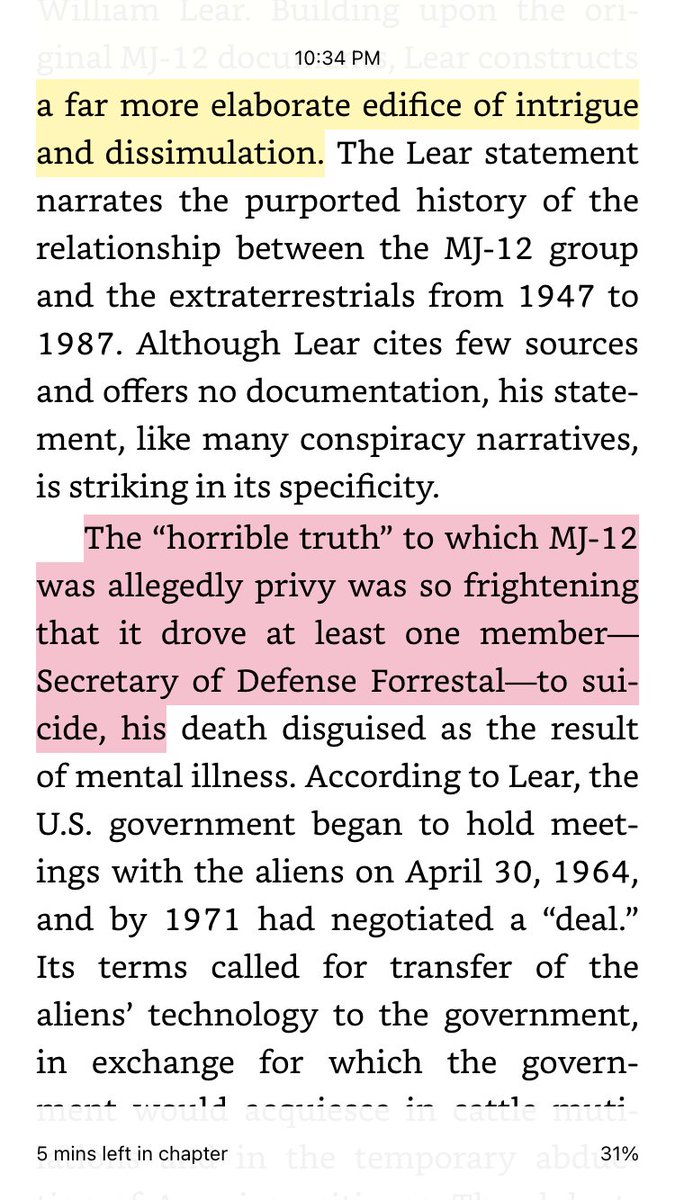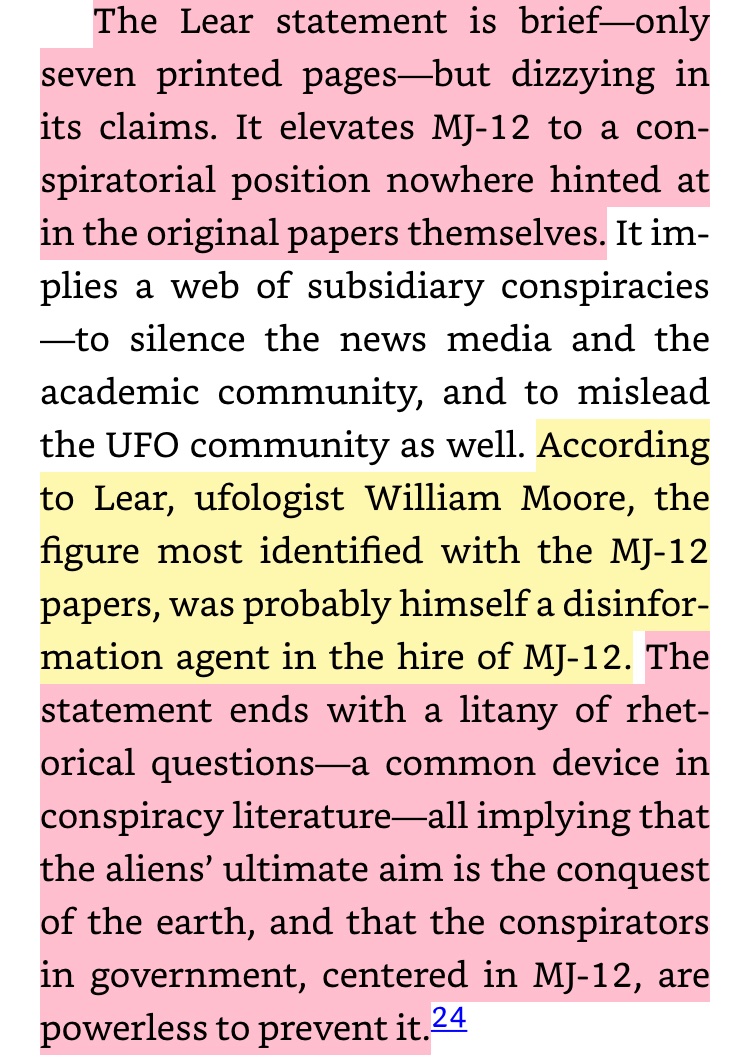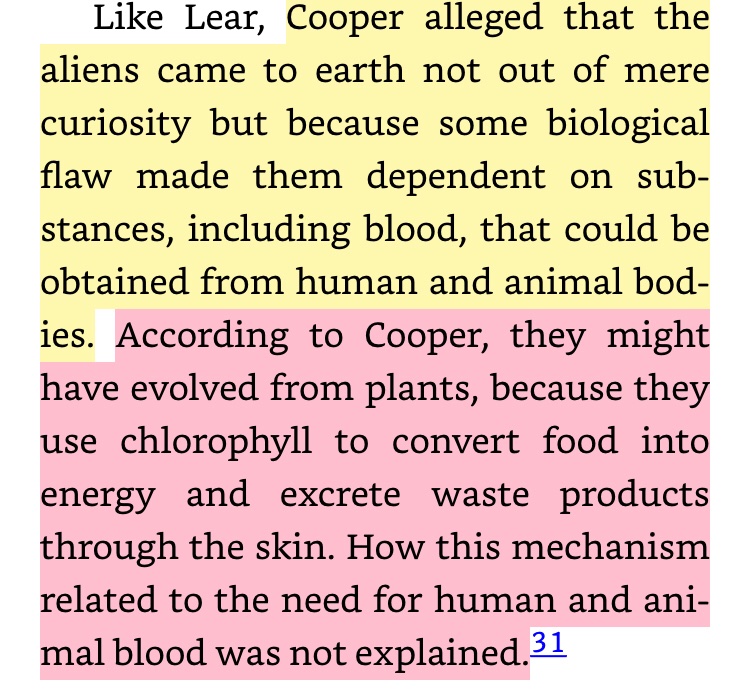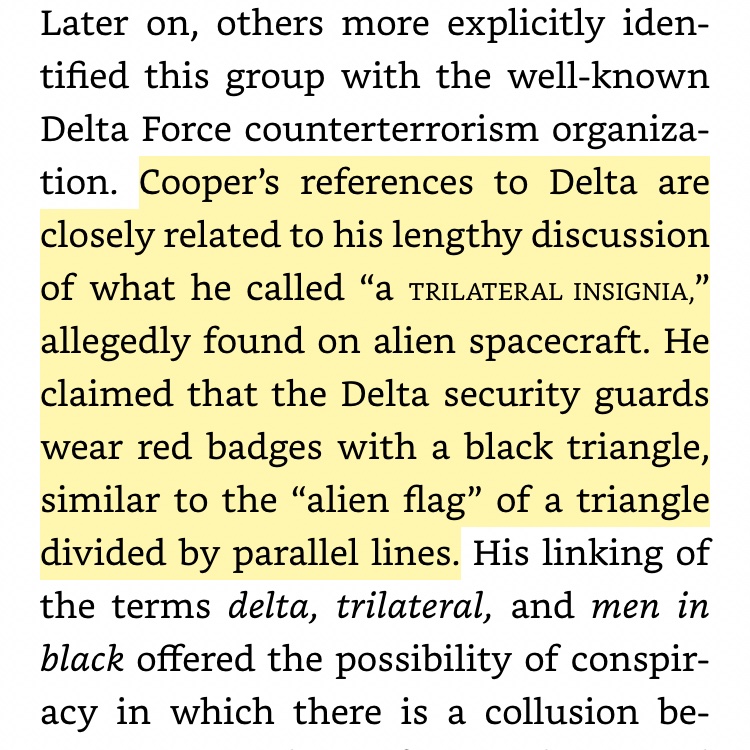Off topic: I’m working my way through Michael Barkun’s “A Culture of Conspiracy” (STRONGLY recommended), and its account of the origins and spread of the “Majestic-12” conspiracy theory is awfully familiar. It even features Usenet!
Don’t take my word for it, though: read on!
Don’t take my word for it, though: read on!
So it allegedly starts with these documents anonymously sent through the mail (you might even say *posted* by an *anon*, in fact :D).
And what do they say?
That the federal government has known UFOs were really extraterrestrial since the 1940s & has kept it secret for Reasons.
And what do they say?
That the federal government has known UFOs were really extraterrestrial since the 1940s & has kept it secret for Reasons.
Have you heard this story before? Yeah, a million times, but this is where it all began.
But the *real* reason I say this sounds familiar is: *as soon as the MJ-12 documents were widely known to UFO enthusiasts, there were a host of spin-offs & “newly discovered documents.”*
But the *real* reason I say this sounds familiar is: *as soon as the MJ-12 documents were widely known to UFO enthusiasts, there were a host of spin-offs & “newly discovered documents.”*
In other words: the LARP was taking off and people wanted to get in on it, because it’s fun to build a shared universe.
(“LARPing” is an ahistorical term to use, of course. But clearly what’s going on here is collaborative worldbuilding & storytelling, *like* you see in Q.)
(“LARPing” is an ahistorical term to use, of course. But clearly what’s going on here is collaborative worldbuilding & storytelling, *like* you see in Q.)
Plus, there were rhetorical advantages to the idea that the government *knows* the truth, but is hiding it: you’re totally free to go “Can I PROVE it? No, because they’re HIDING the proof, because this knowledge is too terrible to bear.”
But watch how the story develops next.
But watch how the story develops next.
The first successful spinoff VASTLY expands the story: now the federal government has made a *deal* with the aliens (who, incidentally, are kidnapping hundreds of thousands of humans and torturing them, often in underground facilities — echoed are sub-strands of Q today).
Note the red-highlighted text in image #3 from that last tweet: Lear’s new, improved version of MJ-12 “ends with a litany of rhetorical questions,” which: also a wee bit familiar.
BTW, this upgraded “2.0” version of MJ-12 was fucking rad as shit; there’s no other way to say it.
BTW, this upgraded “2.0” version of MJ-12 was fucking rad as shit; there’s no other way to say it.
It was basically the plot of “The X-Files,” so I’m not gonna elaborate further. But it gets an A+ for cultural impact.
But wait, there’s a THIRD GENERATION of MJ-12 information that *also* gets an A+ for cultural impact: Bill Cooper’s claims, which crawled off of Usenet in ‘89.
But wait, there’s a THIRD GENERATION of MJ-12 information that *also* gets an A+ for cultural impact: Bill Cooper’s claims, which crawled off of Usenet in ‘89.
Bill Cooper looked at this *wildly* popular idea that was sweeping through the ranks of UFO nerds nationwide (except for the skeptics, but who cares about them?), and said:
“I *really* wanna get me some of that attention, but I absolutely do not want to share the credit.”
“I *really* wanna get me some of that attention, but I absolutely do not want to share the credit.”
And you know what? Bill Cooper lived his fucking dream, and became the #1 conspiracy theorist in America on the back of his theories.
So what were they? Well, PARTLY they seem to have been based on him thinking Little Shop of Horrors was a goddamn documentary or something:
So what were they? Well, PARTLY they seem to have been based on him thinking Little Shop of Horrors was a goddamn documentary or something:
But mostly they consist of claiming that he already knew the MJ-12 stuff bc of his time in the service, but he hadn’t come forward yet because Reasons(tm) BUT ANYWAY here are his study notes which definitely date back to the 1970s.
OK, not the ACTUAL NOTES, but a typed-up copy!
OK, not the ACTUAL NOTES, but a typed-up copy!
(In fairness on this last point, he was posting this to Usenet in 1989. What was he going to do, scan his definitely-real notebooks and post a PDF? He also gave a speech about this at a UFO convention and IDK if he produced the allegedly original notes.)
Anyway, his version was notable for two reasons: first, it folded in the “black helicopters” theme from right-wing mythology — fusing UFOs and militia mythology would be the basis of Cooper’s later career, so *good instincts there*, Bill!
(BTW, he also explained the Men in Black of UFO lore. So he really was paving the way for the merger of UFO enthusiasts and right-wing fascists that we see today in QAnon, and in fact a good chunk of this book is about *the fact that this happened before in the 1990s*.)
Anyway. The second notable thing about Cooper’s theory is that it starts fumbling towards the idea that the conspiracists use elaborate, hidden visual symbolism — but I may be misreading this line because I’m not very familiar with the source material, so don’t take it as fact.
Bottom line: we start with a single-source, very LARPy document. It circulates among a small group of sweaty nerds for a little while, then breaks out to a *wider* group of sweaty nerds.
Once it’s in public, new (and *even more exciting*) versions appear with dizzying speed.
Once it’s in public, new (and *even more exciting*) versions appear with dizzying speed.
And within a few years, these ideas are *deeply* embedded in American popular culture — not necessarily believed *wholeheartedly*, or even believed in *any of their specifics*, but part of the culture nonetheless.
It’s a fascinating story, and Barkun’s whole book is like this.
It’s a fascinating story, and Barkun’s whole book is like this.

 Read on Twitter
Read on Twitter